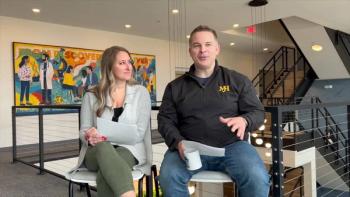
PFS Valid Surrogate Endpoint for OS in Untreated DLBCL
New data support PFS as a surrogate endpoint for OS in future trials evaluating chemoimmunotherapy in DLBCL.
The treatment effect on progression-free survival (PFS) was a strong predictor of treatment effect on overall survival (OS) in first-line treatment of patients with diffuse large B-cell lymphoma (DLBCL), according to the results of the retrospective SEAL study.
“More efficient approaches are needed to promote the development of novel therapies in a timely manner, provide patients earlier access to more effective therapeutic options, and more rapidly evaluate and discard approaches that do not have a clinically significant impact,” Qian Shi, PhD, of the department of health sciences research at the Mayo Clinic, and colleagues wrote in the
In the study, Shi and colleagues looked at PFS and PFS at 24 months (PFS24) as surrogate endpoints for OS in individual patient data (IPD) from 7,507 patients that were included in 13 multicenter randomized trials. All patients had untreated DLBCL, and included studies were published after 2002.
IPD data were used because “unlike literature-based meta-analyses, use of IPD ensured the consistent determination of endpoints and the consistent interpretation of within-trial treatment effects across all studies.”
According to the study, trial-level surrogacy for PFS and patient-level correlation between PFS and OS considering the entire duration of follow-up was strong, meeting predefined criteria for surrogacy.
“The surrogate threshold effect had a hazard ratio (HR) of 0.89, which indicated that an observed HR ≥ 0.89 for PFS would predict a significant treatment effect on OS in a future trial,” the researchers explained.
The correlation between PFS and OS was consistent regardless of the inclusion of rituximab in induction therapy and/or the maintenance regimen.
The PFS24 endpoint was not as robust for OS as PFS was, and it failed to meet the predefined criteria for surrogacy. According to the researchers, “the surrogate threshold effect had an overall response (OR) of 1.51, which indicated that an observed OR ≥ 1.51 for PFS24 would predict a significant treatment effect on OS in a future trial.”
“Future research examining PFS24 and new candidates for surrogacy should be carried out as the SEAL collaboration continues to actively pursue additional trials and data. For emerging novel agents substituted in or combined with R-CHOP, PFS can be an appropriate surrogate endpoint when the expected mechanism for improving OS is long-term disease control,” wrote to the researchers.
Newsletter
Stay up to date on recent advances in the multidisciplinary approach to cancer.

















































































